May 2006
PSC Falcon 4400 now runs Windows Mobile 5.0
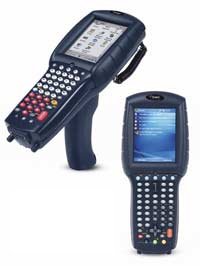 PSC Inc., part of the Datalogic Group, and a global leader in data collection technology announced that its rugged flashlight-style Falcon 4400 Series can now use the Windows Mobile 5.0 OS. The Falcon 4400, powered by a 400MHz Intel PXA255, is a durable and ergonomic mobile computer designed for warehouse, distribution center, and retail in-store environments. In addition to OS flexibility (WinMo 5.0, CE.Net 4.2 and 5.0) the Falcon 4400 family provides a wide range of bar code scan engines, including a Standard Range Laser, a Long Range Laser, an Advanced Long Range Laser, and a 2D Imager. A variety of keyboards such as 26-, 48- and 52-key keypads allow further customization for specific uses. [see Falcon 4400 produc page] -- Posted Tuesday, May 30, 2006
PSC Inc., part of the Datalogic Group, and a global leader in data collection technology announced that its rugged flashlight-style Falcon 4400 Series can now use the Windows Mobile 5.0 OS. The Falcon 4400, powered by a 400MHz Intel PXA255, is a durable and ergonomic mobile computer designed for warehouse, distribution center, and retail in-store environments. In addition to OS flexibility (WinMo 5.0, CE.Net 4.2 and 5.0) the Falcon 4400 family provides a wide range of bar code scan engines, including a Standard Range Laser, a Long Range Laser, an Advanced Long Range Laser, and a 2D Imager. A variety of keyboards such as 26-, 48- and 52-key keypads allow further customization for specific uses. [see Falcon 4400 produc page] -- Posted Tuesday, May 30, 2006
UMPC Review: Samsung Q1
Tim Hillebrand reviews the first Ultra Mobile PC available on the market, the Samsung Q1. Read his review here. -- Posted Saturday, May 27, 2006
Ultra Mobile PC Update
Pen Computing Technology Editor Geoff Walker offers a comprehensive update on Microsoft's "Origami" Ultra Mobile PC (UMPC), including analyst reactions, shipping products, new and concept devices announced, future products, software released and planned, vertical market potential, touch-screen issues, and outlook. View our Ultra Mobile PC Update.
-- Posted Thursday, May 25, 2006
Microsoft plans "Vistagami" mini Tablet PCs
At WinHEC, Microsoft expressed its disappointment at the high pricepoint of most current and planned "Origami" Ultra Mobile PCs. The plan was for US$500 devices, but some of the first, like the Samsung Q1, start at well over a grand. The use of less expensive electronics (like Via processors, etc.) helps some vendors, like Tablet Kiosk, offer lower prices, and some analysts project sales of up to 8 million a year by 2011. With its higher hardware requirements, it's hard to see how Vista-based UMPCs could costs less, so we'll have to wait and see how much competition and component costs will drive prices down. -- Posted Thursday, May 25, 2006
UMPCs with flash instead of conventional hard drives?
 Hard drives still crash and they are still among the most vulnerable parts of a notebook (or any computer). As a result, Samsung is now releasing mobile computers with 32GB embedded NAND Flash "solid state disks" (SSDs). The experiment starts with the Q1 Ultra Mobile PC and the Q30 ultra-light notebook. The SSD-based devices resolve many of the challenges of mobile computers. Data in flash memory is more secure against external shocks as the SSD can withstand about twice the impact of a regular hard disk drive. SSD reads 300 percent faster (53MB/s) and writes 150 percent quicker (28MB/s) than normal hard drives. As a result, Windows XP boots up 25-50% faster. In addition, while the typical 1.8-inch hard disk weighs over two ounces, the SSD, depending on the package type, weighs half that. And there is no hard drive noise and power consumption is lower. The glitch, for now, is price. [see Samsung release] -- Posted Thursday, May 25, 2006
Hard drives still crash and they are still among the most vulnerable parts of a notebook (or any computer). As a result, Samsung is now releasing mobile computers with 32GB embedded NAND Flash "solid state disks" (SSDs). The experiment starts with the Q1 Ultra Mobile PC and the Q30 ultra-light notebook. The SSD-based devices resolve many of the challenges of mobile computers. Data in flash memory is more secure against external shocks as the SSD can withstand about twice the impact of a regular hard disk drive. SSD reads 300 percent faster (53MB/s) and writes 150 percent quicker (28MB/s) than normal hard drives. As a result, Windows XP boots up 25-50% faster. In addition, while the typical 1.8-inch hard disk weighs over two ounces, the SSD, depending on the package type, weighs half that. And there is no hard drive noise and power consumption is lower. The glitch, for now, is price. [see Samsung release] -- Posted Thursday, May 25, 2006
Rand McNally Mobile Navigator
Motorists who don't want to buy an expensive in-car navigation system or a separate GPS-enabled PDA now have an inexpensive alternative. Rand McNally, provider of America's most trusted maps and directions, today introduced Rand McNally MONA (Mobile Navigator), a mobile phone-based navigation system that puts reliable directions at drivers' fingertips. [see how it works] -- Posted Wednesday, May 24, 2006
ProtectStar Mobile Firewall
ProtectStar Inc. is launching the first Mobile Firewall for appliances with the Windows Mobile operating system, "ProtectStar Mobile Firewall." The product is designed to keep hackers from accessing unprotected data and appliances. It is possible to steal confidential data such as passwords, files or addresses in a matter of minutes. And it's easy to modify computers, even Handhelds, and infiltrate a system with destructive viruses, worms and Trojan horses. The ProtectStar Mobile Firewall for Windows Mobile Pocket PCs, handhelds and smartphones provides IP filters for WiFi, UMTS, GPRS, Bluetooth, and USB, protecting mobile appliances in two directions: a filter package monitors both sent and received data. The entire TCP/IP traffic between the computer and the Internet is thus under permanent surveillance. -- Posted Wednesday, May 24, 2006
Handango to offer Windows Mobile and Tablet PC apps through Windows Marketplace
Handango, the leading provider of mobile content, announced it will provide Windows Mobile and Tablet PC content on Windows Marketplace, a shopping portal for customers to find and buy software and hardware for the Windows operating system. The mobile catalog will include games, entertainment, productivity content and more from Handango's catalog of more than 190,000 titles and will offer commerce and electronic software download delivery through Handango's robust content provisioning system, Handango AMPP. -- Posted Wednesday, May 24, 2006
Verizon to offer sexy Moto Q by end of May
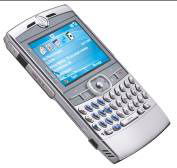 CNET reports that Verizon will be the first to sell the Windows Mobile-based sexy Motorola Q phone when it goes on sale May 31 for US$199.99 with 2-year service contract and after rebates. One look at the Q suggests that this is Motorola's attempt at going after the lucrative BackBerry market with a device that offers similar design and functionality, but also includes a much broader range of features, such as video, music, and access to corporate applications. -- Posted Tuesday, May 23, 2006
CNET reports that Verizon will be the first to sell the Windows Mobile-based sexy Motorola Q phone when it goes on sale May 31 for US$199.99 with 2-year service contract and after rebates. One look at the Q suggests that this is Motorola's attempt at going after the lucrative BackBerry market with a device that offers similar design and functionality, but also includes a much broader range of features, such as video, music, and access to corporate applications. -- Posted Tuesday, May 23, 2006
ProMedica adopts mobile PatientKeeper applications
ProMedica Health System, the largest health care provider in northwest Ohio and southeast Michigan, today announced that it has adopted PatientKeeper as its physician information system. Physicians use the PatientKeeper Mobile Clinical Results application to access their patients' medical records and the PatientKeeper Charge Capture application to accurately record the services they provide. PatientKeeper can support any tablet or PC running a Web browser as well as Palm OS and Windows Mobile devices. -- Posted Tuesday, May 23, 2006
Palm Treo 700p now available online
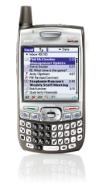 The recently announced Palm OS-based Palm Treo 700p smartphone is available online today and will be available in Verizon Wireless Communication Stores on June 1. The Treo 700p smartphone includes hardware and software innovations centered around usability, connectivity, multimedia and compatibility, designed to take advantage of the fast EV-DO data speeds of Verizon Wireless' BroadbandAccess service. With the 128MB Treo 700p, Verizon Wireless customers can also enjoy fast EV-DO speeds on their laptop computers with BroadbandAccess Connect, which turns the 700p into a wireless modem. Watch for a full Pen Computing review of the Treo 700p shortly. -- Posted Tuesday, May 23, 2006
The recently announced Palm OS-based Palm Treo 700p smartphone is available online today and will be available in Verizon Wireless Communication Stores on June 1. The Treo 700p smartphone includes hardware and software innovations centered around usability, connectivity, multimedia and compatibility, designed to take advantage of the fast EV-DO data speeds of Verizon Wireless' BroadbandAccess service. With the 128MB Treo 700p, Verizon Wireless customers can also enjoy fast EV-DO speeds on their laptop computers with BroadbandAccess Connect, which turns the 700p into a wireless modem. Watch for a full Pen Computing review of the Treo 700p shortly. -- Posted Tuesday, May 23, 2006
Parascript uses reco expertise for financial document processing
Sometimes you gotta go where the money is. At some point Paragraph/Parascript was at the forefront of handwriting recogniton, and every Pocket PC and Tablet PC still contains successors of the ParaGraph recognition engine code to this day. Yet, Parascript itself moved to greener pastures. Parascript LLC now calls itself "the Intelligent Recognition technology provider for the banking and financial industry", and just announced the next generation of Parascript CheckPlus, the only financial document processing solution that combines check processing, forms processing and fraud detection. -- Posted Tuesday, May 23, 2006
Mitac beefs marketing budget for GPS push
 DigiTimes reports that Mitac will spend over US$30 million in marketing and promoting its impressive line of GPS and GPS-enabled devices (see DigiTimes photo). The company hopes to ship four million of them this year. Our take: GPS-enabled Pocket PCs and standalones have been one of the few bright spots in an otherwise dismal "conventional" PDA market. Adding GPS gave Mitac a bit of an extra edge, but we're not sure it's enough for sustained growth. That will likely require addition of phone and digital TV features. -- Posted Tuesday, May 23, 2006
DigiTimes reports that Mitac will spend over US$30 million in marketing and promoting its impressive line of GPS and GPS-enabled devices (see DigiTimes photo). The company hopes to ship four million of them this year. Our take: GPS-enabled Pocket PCs and standalones have been one of the few bright spots in an otherwise dismal "conventional" PDA market. Adding GPS gave Mitac a bit of an extra edge, but we're not sure it's enough for sustained growth. That will likely require addition of phone and digital TV features. -- Posted Tuesday, May 23, 2006
Moviews2go: transfer movies, video, slideshows to mobile devices
MAGIX, a leader in music and video editing software, announced MAGIX Movies2go, an application that lets you transfer videos and slideshows to mobile devices, including portable video players (such as the Sony PSP and iPods), cell phones, PDAs, and laptops, to experience and show off videos. MAGIX Movies2go is for anyone that wants to create their own mobile entertainment center and watch videos and TV shows everywhere. Movies2go allows easy transfer and conversion of videos and slideshows in just a few steps into MPEG4, 3GP, and many other formats compatible with video playback devices or laptops -- Posted Monday, May 22, 2006
U.S. Army awards contract extension for flexible OLED displays
 Universal Display Corporation, who is developing and commercializing OLED technology for flat panel displays, lighting and other opto-electronics with its proprietary PHOLED phosphorescent OLED technology, announced it has been awarded a $1.275 million contract extension from the U.S. Army Communication Electronics Research and Development Engineering Center (CERDEC). The full-color AMOLED display device is enabled by Universal Display’s proprietary PHOLED, TOLED top-emitting OLED and FOLED flexible OLED technologies, as well as by PARC’s low-temperature, poly-Silicon TFT technology. The electronics and packaging for the wrist-based device are from L-3 Communications – Display Systems. -- Posted Monday, May 22, 2006
Universal Display Corporation, who is developing and commercializing OLED technology for flat panel displays, lighting and other opto-electronics with its proprietary PHOLED phosphorescent OLED technology, announced it has been awarded a $1.275 million contract extension from the U.S. Army Communication Electronics Research and Development Engineering Center (CERDEC). The full-color AMOLED display device is enabled by Universal Display’s proprietary PHOLED, TOLED top-emitting OLED and FOLED flexible OLED technologies, as well as by PARC’s low-temperature, poly-Silicon TFT technology. The electronics and packaging for the wrist-based device are from L-3 Communications – Display Systems. -- Posted Monday, May 22, 2006
Fingerprint authentication spreading
Digital Persona, Inc., a provider of fingerprint authentication solutions for enterprise networks and commercial applications, announced the latest version of its award-winning enterprise solution DigitalPersona Pro v 3.5, with support for notebooks from Dell, HP, and Toshiba with embedded fingerprint readers. Digital Persona had previously announced support for specific models of Lenovo/IBM and Itronix notebooks. "International Biometric Group estimates that the use of biometrics to identify individuals accessing computing devices will reach $906.2 million by 2010," said Victor Lee, of International Biometric Group. [List of supported notebooks] -- Posted Monday, May 22, 2006
Symbian celebrates: 100 phone, 250 networks, 70.5 million shipped.
Symbian Ltd. today announced that the Symbian open mobile operating system for advanced, data-enabled mobile phones/smartphones has shipped in 100 different commercial phone models to over 250 major network operators worldwide. In its Q1 2006 results issued today, Symbian also announced it had shipped 70.5 million phones to date worldwide since its formation. [see release] -- Posted Tuesday, May 16, 2006
MyScript handwriting reco now available for Linux
The handwriting recognition technology experts at Vision Objects have released MyScript Builder Embedded 1.2 dedicated to mobile devices. This new version features additional languages, offers better accuracy and is now also available for Linux. MyScript Builder Embedded is the only solution on the market able to recognize truly natural handwriting on Linux and Symbian Operating Systems. This Software Development Kit is designed for integration of handwriting recognition capabilities into small footprint platforms such as PDAs, Internet Tablets and Smartphones. It recognizes all handwriting styles in a wide range of languages and addresses markets in the Americas, Europe and Asia-Pacific. -- Posted Tuesday, May 16, 2006
Sony introduces tiny full-function PC
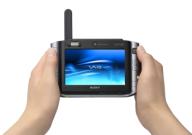 What's smaller -- by a lot -- than the new generation of Microsoft-spec Ultra-Mobile PCs? That would be the new Sony Vaio UX Micro PC. Though it is barely larger than a Pocket PC and has a screen measuring just 4.5 inches diagonally, the little Sony is a full-function PC running on a Intel Core Solo ULV chip. For connectivity there is Bluetooth, WiFi, plain old Ethernet, and even WWAN to use Cingular's EDGE data network. The little thing has not one, but two digital cameras, one to take pics, the other for video conferencing. There is a biometric fingerprint reader to keep unauthorized access at bay, three USB 2.0 ports, FireWire, audio in/out, etc. The device weighs just over a 16 ounces, and its touch screen slides up to reveal a tiny keyboard. The price is fairly high: expect around US$1,800. -- Posted Tuesday, May 16, 2006
What's smaller -- by a lot -- than the new generation of Microsoft-spec Ultra-Mobile PCs? That would be the new Sony Vaio UX Micro PC. Though it is barely larger than a Pocket PC and has a screen measuring just 4.5 inches diagonally, the little Sony is a full-function PC running on a Intel Core Solo ULV chip. For connectivity there is Bluetooth, WiFi, plain old Ethernet, and even WWAN to use Cingular's EDGE data network. The little thing has not one, but two digital cameras, one to take pics, the other for video conferencing. There is a biometric fingerprint reader to keep unauthorized access at bay, three USB 2.0 ports, FireWire, audio in/out, etc. The device weighs just over a 16 ounces, and its touch screen slides up to reveal a tiny keyboard. The price is fairly high: expect around US$1,800. -- Posted Tuesday, May 16, 2006
Mitac rides the GPS wave
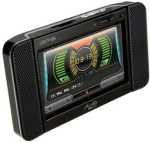 According to Digitimes, Mitac's Mio Technology subsidiary shipped over half a million GPS-enabled devices in the first quarter 2006, and second quarter shipments could be a million. According to the report, TomTom shipped over 750k units and Garmin 920k during the first quarter. Looking ahead, Mitac is said to focus on GPS-enabled handhelds that also include phone and digital TV functionality. A TV-enabled device GPS device, the Mio C810 (shown in picture), was launched in South Korea early May. -- Posted Tuesday, May 16, 2006
According to Digitimes, Mitac's Mio Technology subsidiary shipped over half a million GPS-enabled devices in the first quarter 2006, and second quarter shipments could be a million. According to the report, TomTom shipped over 750k units and Garmin 920k during the first quarter. Looking ahead, Mitac is said to focus on GPS-enabled handhelds that also include phone and digital TV functionality. A TV-enabled device GPS device, the Mio C810 (shown in picture), was launched in South Korea early May. -- Posted Tuesday, May 16, 2006
BlackBerry signature capture solution
Standard Register's ExpeData Digital Solutions group announced a digital signature capability for BlackBerry. It will be offered to BlackBerry Independent Software Vendors (ISV) as a toolkit that can be integrated into BlackBerry-based applications, enabling mobile workers to capture signatures and route them wirelessly to back-end systems using the BlackBerry. The ExpeData toolkitincludes a Logitech digital pen and pocket-sized digital paper pad and allows for convenient signature capture. Images of the signature are viewable on the BlackBerry screen and a record of the date stamp and time stamp associated with the signature are available to third-party BlackBerry application providers. -- Posted Monday, May 15, 2006
Luminaries gather to discuss future of computing
Will it always just be a faster Intel processor and a bigger, fatter version of Windows? Or will the future of computing be a whole lot more? That's what an illustrious groups of luminaries gathered to discuss in a cognitive computing conference at IBM's Almaden research Center. Participants included a Nobel laureate, math and neuroscience professors, and, of course, our favorite by far, Jeff Hawkins, founder of Palm, Handspring and Numenta, inventor of Graffiti, and author of On Intelligence in which he brilliantly outlined the functioning of the neocortex and, from it, proposed the Hierarchical Temporal Memory platform as a central building block to completely different computing machines. Someone in the audience supposedly suggested he should stick with Treos. Our take is that we never write anything off that Jeff Hawkins works on. -- Posted Friday, May 12, 2006
Good snatches large account from RIM
Good Technology, a provider of industry standards-based enterprise handheld computing software and service, today announced that Thomson has replaced its BlackBerry system with over a thousand GoodLink-enabled Palm OS based Treo 650 smartphones, and Pocket PC devices. The company is running GoodLink on carriers Sprint and T-Mobile in the United States, and Orange in Europe. Our take: This may be just the beginning of a lot of switching over from RIM after RIM showed a willingness to settle with patent infringement attempts, which practically invites further lawsuits, plus a general move towards more industry standard solutions. -- Posted Thursday, May 11, 2006
Conventional PDAs continue to drop
According to eChannelLine, a new IDC report says that the worldwide market for conventional handhelds continues to drop. It's now down to 1.5 million units the first quarter of 2006, and that despite integration of WiFi, GPS, Bluetooth, VGA screens, etc. The biggest problem is that many of those features are available in the booming smartphone market. Palm is still on top with conventional handhelds, following a good reception of the Tungsten E2 and the Z22 last year. However, Palm's Treo smartphone business is now larger than its PDA business. HP, though sputtering, continues to hold the #2 spot. Dell is at #3, but the x30/x50 lines are pretty much end-of-life. The 4 and 5 spots are held by Acer and Mio. Mio is also the only top five vendor with a hefty sales increase. -- Posted Monday, May 8, 2006
Satellite radio losses grow larger
Sometimes it's hard to figure out how business works. Amazon lost huge fortunes for years, yet emerged as Number One. TiVo is loved by all who use it, its subscriber list is growing, and it just won a major patent lawsuit. Yet, no one is especially optimistic about TiVo. Satellite radio is a huge thing these days, with the two main competitors -- Sirisu and XM -- rapidly signing up subscribers by the millions. Sirius expects to have 6.2 million by the end of 2006, XM is already past that number. Yet, neither is making money. Sirius just lost US$458 million in the last quarter, the cost of adding a single new subscriber is $113, and they have this deal with Howard Stern that pays Stern $500 million over five years. Will satellite radio take off in a big way? -- Posted Wednesday, May 3, 2006
Samsung launches Q1 UMPC
Samsung announced the official U.S. launch of its Ultra Mobile PC (UMPC), the Q1. The Q1 will retail for US$1,099 in the U.S. and there will be various options, including a USB keyboard, organizer, extended battery and an external optical drive. Samsung said the Q1 will be available at Best Buy's e-tail outlet, www.bestbuy.com/ultramobilepc, beginning May 7, and in select Best Buy stores later this summer as part of a collaboration between the two companies. The Q1 is also expected to generate synergy for Samsung as it begins bundling the UMPC with its line of printers, monitors and other IT products in the American market, and examines ways to seek diverse solutions through its more than 15,000 IT resellers. As for position, "The Q1 is a good companion PC for the mobile professional that is looking for the freedom and flexibility of a small mobile device without having to sacrifice functionality," said HS Kim, executive vice president of Samsung Electronics Computer System Division. "This product marks the beginning of a revolution for PCs and PC use." -- Posted Monday, May 1, 2006
TabletKiosk UMPC glitch costs "first-to-market"
news.com reports that a glitch in the TabletKiosk EO "Origami" UMPC means shipping will be delayed until June. The bragging rights for the first UMPS released will therefore go to Samsung which is planning a US launch of its UMPC this week. Assorted experts still squabble over the market size for UMPCs. Consensus seems to be that it will be small initially, but at least according to an In-Stat report, the UMPC market could grow to 7.8 million units by 2011. Nice to have that sort of crystal ball. -- Posted Monday, May 1, 2006
Nokia Nseries multimedia/internet phones
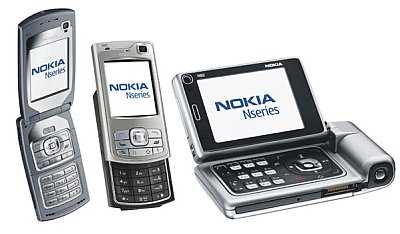 Nokia unveiled three stunning Nokia Nseries multimedia smartphones, all pushing high-quality video and photo capture, great audio and high speed Internet The Nokia N93 has a 3.2 megapixel camera with Carl Zeiss optics, DVD-like 30fps video capture, and 3x optical zoom with video stabilization. You can even connect the Nokia N93 directly to a widescreen TV. The Nokia N73 has integrated stereo speakers with 3D sound. It, too, has a 3.2 megapixel camera with Carl Zeiss optics, auto focus and support for uploading your photos to the Flickr.com photo community. The attractive glossy Nokia N72 has a 2 megapixel camera and integrated digital music player, with dedicated capture and music keys as well as an FM radio and support for Visual Radio. The N93 and N73, are based on the S60 3rd Edition Symbian OS, will be available in July 2006, the N72 in June. -- Posted Monday, May 1, 2006
Nokia unveiled three stunning Nokia Nseries multimedia smartphones, all pushing high-quality video and photo capture, great audio and high speed Internet The Nokia N93 has a 3.2 megapixel camera with Carl Zeiss optics, DVD-like 30fps video capture, and 3x optical zoom with video stabilization. You can even connect the Nokia N93 directly to a widescreen TV. The Nokia N73 has integrated stereo speakers with 3D sound. It, too, has a 3.2 megapixel camera with Carl Zeiss optics, auto focus and support for uploading your photos to the Flickr.com photo community. The attractive glossy Nokia N72 has a 2 megapixel camera and integrated digital music player, with dedicated capture and music keys as well as an FM radio and support for Visual Radio. The N93 and N73, are based on the S60 3rd Edition Symbian OS, will be available in July 2006, the N72 in June. -- Posted Monday, May 1, 2006
 Hard drives still crash and they are still among the most vulnerable parts of a notebook (or any computer). As a result, Samsung is now releasing mobile computers with 32GB embedded NAND Flash "solid state disks" (SSDs). The experiment starts with the Q1 Ultra Mobile PC and the Q30 ultra-light notebook. The SSD-based devices resolve many of the challenges of mobile computers. Data in flash memory is more secure against external shocks as the SSD can withstand about twice the impact of a regular hard disk drive. SSD reads 300 percent faster (53MB/s) and writes 150 percent quicker (28MB/s) than normal hard drives. As a result, Windows XP boots up 25-50% faster. In addition, while the typical 1.8-inch hard disk weighs over two ounces, the SSD, depending on the package type, weighs half that. And there is no hard drive noise and power consumption is lower. The glitch, for now, is price. [see Samsung release] -- Posted Thursday, May 25, 2006
Hard drives still crash and they are still among the most vulnerable parts of a notebook (or any computer). As a result, Samsung is now releasing mobile computers with 32GB embedded NAND Flash "solid state disks" (SSDs). The experiment starts with the Q1 Ultra Mobile PC and the Q30 ultra-light notebook. The SSD-based devices resolve many of the challenges of mobile computers. Data in flash memory is more secure against external shocks as the SSD can withstand about twice the impact of a regular hard disk drive. SSD reads 300 percent faster (53MB/s) and writes 150 percent quicker (28MB/s) than normal hard drives. As a result, Windows XP boots up 25-50% faster. In addition, while the typical 1.8-inch hard disk weighs over two ounces, the SSD, depending on the package type, weighs half that. And there is no hard drive noise and power consumption is lower. The glitch, for now, is price. [see Samsung release] -- Posted Thursday, May 25, 2006 PSC Inc., part of the Datalogic Group, and a global leader in data collection technology announced that its rugged flashlight-style Falcon 4400 Series can now use the Windows Mobile 5.0 OS. The Falcon 4400, powered by a 400MHz Intel PXA255, is a durable and ergonomic mobile computer designed for warehouse, distribution center, and retail in-store environments. In addition to OS flexibility (WinMo 5.0, CE.Net 4.2 and 5.0) the Falcon 4400 family provides a wide range of bar code scan engines, including a Standard Range Laser, a Long Range Laser, an Advanced Long Range Laser, and a 2D Imager. A variety of keyboards such as 26-, 48- and 52-key keypads allow further customization for specific uses. [see Falcon 4400 produc page] -- Posted Tuesday, May 30, 2006
PSC Inc., part of the Datalogic Group, and a global leader in data collection technology announced that its rugged flashlight-style Falcon 4400 Series can now use the Windows Mobile 5.0 OS. The Falcon 4400, powered by a 400MHz Intel PXA255, is a durable and ergonomic mobile computer designed for warehouse, distribution center, and retail in-store environments. In addition to OS flexibility (WinMo 5.0, CE.Net 4.2 and 5.0) the Falcon 4400 family provides a wide range of bar code scan engines, including a Standard Range Laser, a Long Range Laser, an Advanced Long Range Laser, and a 2D Imager. A variety of keyboards such as 26-, 48- and 52-key keypads allow further customization for specific uses. [see Falcon 4400 produc page] -- Posted Tuesday, May 30, 2006 CNET reports that Verizon will be the first to sell the Windows Mobile-based sexy Motorola Q phone when it goes on sale May 31 for US$199.99 with 2-year service contract and after rebates. One look at the Q suggests that this is Motorola's attempt at going after the lucrative BackBerry market with a device that offers similar design and functionality, but also includes a much broader range of features, such as video, music, and access to corporate applications. -- Posted Tuesday, May 23, 2006
CNET reports that Verizon will be the first to sell the Windows Mobile-based sexy Motorola Q phone when it goes on sale May 31 for US$199.99 with 2-year service contract and after rebates. One look at the Q suggests that this is Motorola's attempt at going after the lucrative BackBerry market with a device that offers similar design and functionality, but also includes a much broader range of features, such as video, music, and access to corporate applications. -- Posted Tuesday, May 23, 2006 The recently announced Palm OS-based Palm Treo 700p smartphone is available online today and will be available in Verizon Wireless Communication Stores on June 1. The Treo 700p smartphone includes hardware and software innovations centered around usability, connectivity, multimedia and compatibility, designed to take advantage of the fast EV-DO data speeds of Verizon Wireless' BroadbandAccess service. With the 128MB Treo 700p, Verizon Wireless customers can also enjoy fast EV-DO speeds on their laptop computers with BroadbandAccess Connect, which turns the 700p into a wireless modem. Watch for a full Pen Computing review of the Treo 700p shortly. -- Posted Tuesday, May 23, 2006
The recently announced Palm OS-based Palm Treo 700p smartphone is available online today and will be available in Verizon Wireless Communication Stores on June 1. The Treo 700p smartphone includes hardware and software innovations centered around usability, connectivity, multimedia and compatibility, designed to take advantage of the fast EV-DO data speeds of Verizon Wireless' BroadbandAccess service. With the 128MB Treo 700p, Verizon Wireless customers can also enjoy fast EV-DO speeds on their laptop computers with BroadbandAccess Connect, which turns the 700p into a wireless modem. Watch for a full Pen Computing review of the Treo 700p shortly. -- Posted Tuesday, May 23, 2006 DigiTimes reports that Mitac will spend over US$30 million in marketing and promoting its impressive line of GPS and GPS-enabled devices (see DigiTimes photo). The company hopes to ship four million of them this year. Our take: GPS-enabled Pocket PCs and standalones have been one of the few bright spots in an otherwise dismal "conventional" PDA market. Adding GPS gave Mitac a bit of an extra edge, but we're not sure it's enough for sustained growth. That will likely require addition of phone and digital TV features. -- Posted Tuesday, May 23, 2006
DigiTimes reports that Mitac will spend over US$30 million in marketing and promoting its impressive line of GPS and GPS-enabled devices (see DigiTimes photo). The company hopes to ship four million of them this year. Our take: GPS-enabled Pocket PCs and standalones have been one of the few bright spots in an otherwise dismal "conventional" PDA market. Adding GPS gave Mitac a bit of an extra edge, but we're not sure it's enough for sustained growth. That will likely require addition of phone and digital TV features. -- Posted Tuesday, May 23, 2006
 What's smaller -- by a lot -- than the new generation of Microsoft-spec Ultra-Mobile PCs? That would be the new Sony Vaio UX Micro PC. Though it is barely larger than a Pocket PC and has a screen measuring just 4.5 inches diagonally, the little Sony is a full-function PC running on a Intel Core Solo ULV chip. For connectivity there is Bluetooth, WiFi, plain old Ethernet, and even WWAN to use Cingular's EDGE data network. The little thing has not one, but two digital cameras, one to take pics, the other for video conferencing. There is a biometric fingerprint reader to keep unauthorized access at bay, three USB 2.0 ports, FireWire, audio in/out, etc. The device weighs just over a 16 ounces, and its touch screen slides up to reveal a tiny keyboard. The price is fairly high: expect around US$1,800. -- Posted Tuesday, May 16, 2006
What's smaller -- by a lot -- than the new generation of Microsoft-spec Ultra-Mobile PCs? That would be the new Sony Vaio UX Micro PC. Though it is barely larger than a Pocket PC and has a screen measuring just 4.5 inches diagonally, the little Sony is a full-function PC running on a Intel Core Solo ULV chip. For connectivity there is Bluetooth, WiFi, plain old Ethernet, and even WWAN to use Cingular's EDGE data network. The little thing has not one, but two digital cameras, one to take pics, the other for video conferencing. There is a biometric fingerprint reader to keep unauthorized access at bay, three USB 2.0 ports, FireWire, audio in/out, etc. The device weighs just over a 16 ounces, and its touch screen slides up to reveal a tiny keyboard. The price is fairly high: expect around US$1,800. -- Posted Tuesday, May 16, 2006 According to Digitimes, Mitac's Mio Technology subsidiary shipped over half a million GPS-enabled devices in the first quarter 2006, and second quarter shipments could be a million. According to the report, TomTom shipped over 750k units and Garmin 920k during the first quarter. Looking ahead, Mitac is said to focus on GPS-enabled handhelds that also include phone and digital TV functionality. A TV-enabled device GPS device, the Mio C810 (shown in picture), was launched in South Korea early May. -- Posted Tuesday, May 16, 2006
According to Digitimes, Mitac's Mio Technology subsidiary shipped over half a million GPS-enabled devices in the first quarter 2006, and second quarter shipments could be a million. According to the report, TomTom shipped over 750k units and Garmin 920k during the first quarter. Looking ahead, Mitac is said to focus on GPS-enabled handhelds that also include phone and digital TV functionality. A TV-enabled device GPS device, the Mio C810 (shown in picture), was launched in South Korea early May. -- Posted Tuesday, May 16, 2006 Nokia unveiled three stunning Nokia Nseries multimedia smartphones, all pushing high-quality video and photo capture, great audio and high speed Internet The Nokia N93 has a 3.2 megapixel camera with Carl Zeiss optics, DVD-like 30fps video capture, and 3x optical zoom with video stabilization. You can even connect the Nokia N93 directly to a widescreen TV. The Nokia N73 has integrated stereo speakers with 3D sound. It, too, has a 3.2 megapixel camera with Carl Zeiss optics, auto focus and support for uploading your photos to the Flickr.com photo community. The attractive glossy Nokia N72 has a 2 megapixel camera and integrated digital music player, with dedicated capture and music keys as well as an FM radio and support for Visual Radio. The N93 and N73, are based on the S60 3rd Edition Symbian OS, will be available in July 2006, the N72 in June. -- Posted Monday, May 1, 2006
Nokia unveiled three stunning Nokia Nseries multimedia smartphones, all pushing high-quality video and photo capture, great audio and high speed Internet The Nokia N93 has a 3.2 megapixel camera with Carl Zeiss optics, DVD-like 30fps video capture, and 3x optical zoom with video stabilization. You can even connect the Nokia N93 directly to a widescreen TV. The Nokia N73 has integrated stereo speakers with 3D sound. It, too, has a 3.2 megapixel camera with Carl Zeiss optics, auto focus and support for uploading your photos to the Flickr.com photo community. The attractive glossy Nokia N72 has a 2 megapixel camera and integrated digital music player, with dedicated capture and music keys as well as an FM radio and support for Visual Radio. The N93 and N73, are based on the S60 3rd Edition Symbian OS, will be available in July 2006, the N72 in June. -- Posted Monday, May 1, 2006